by Sarah Segall | Mar 12, 2016 | In The Loop
Language Arts and Science
In Literacy this week, we spent our time reviewing concepts we have been seeing during the last couple weeks, as well taking a few assessments, our spelling quiz on Thursday and a multiple choice reading assessment of the book Adaptaciones on Friday.
As we prepare to close this term, many of our projects are coming to an end. We have finished our first book Practica de destrezas. This is the book our class uses to do all of our Spanish grammar and word work. Our Humphrey book club is another project we will be finishing next week. By this weekend, students should have the entire book read and all their reading logs complete. They will be taking a writing assessment based on the book on Tuesday. Please make sure your child comes to school prepared.
We had another big science week! Our class continued with our investigation 3: Water Tolerance, where students isolated one factor, water, in the environment of plants, and set up and experiment to determine the range of water tolerance for the early growth of four different plants, describe the optimum water conditions for early growth of seed and analyze data from plant experiments. The big hit this week, however, was the introduction of Investigation 4: Aquatic Environments. We compared and contrasted the characteristics of a terrestrial and aquatic environments. We identified different aquatic environments and determined the living and non-living factors we find there. Water and temperature, for example, are two non-living factors. Later in the week, we focused particularly on fresh water environments. Our class assembled a fresh water aquariums and welcomed some cool friends, our little goldfish. We introduced key vocabulary such as, oxygen and carbon dioxide. Next week we will learn about the effect that carbon dioxide produces in the water. Stay tuned!
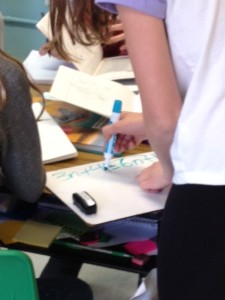
Algebra is fun!
Math
We learned a few more complicated steps in algebra this week, and everyone did very well at mastering the new concepts! One thing that was tricky for some was following the steps taught even if the correct answer could be visualized. It was discussed that without the proper methods, it won’t be quite as easy to visualize answers once our algebra gets more and more difficult. So it is very important to master the steps now when algebraic equations are easier!
At the end of this week students are able to:
-Write and evaluate inequalities
-determine the difference between algebraic inequalities and equations
-solve for simple algebraic equations with variables and inequalities
-find the value of variables in simple algebraic equations
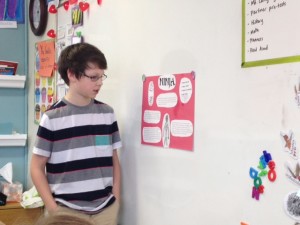 History & Geography
History & Geography
We got a little bit further in our study of the Westward expansion and also heard from a remaining few Feudal Japan presentations this week.
At the end of this week students are able to:
- gain a deeper understanding about pioneers, land routes (Santa Fe and Oregon Trails) and the Gold Rush
- point out geographical areas of importance such as the Erie Canal, Appalachian and Rocky mountains, various rivers, the Great Plains and the Continental Divide
- Explain about the Indian resistance
- Understand the meaning of ‘Manifest Destiny’
Art
The 4th and 5th graders finished their Origami Radial Symmetry designs this week in art. They look like beautiful 3dimensional quilt patterns! These are displayed on the wall next to their Feudal Japan bulletin board.
Music
This week we followed the daily Google doodle to discover the heritage of Lithuanian-born Clara Rockwell, an early player of the first electronic musical instrument, the theramin. The doodle offered a quick theramin lesson, and gave the students a chance to try their own melodies.
Theramin Link
by Sarah Segall | Mar 12, 2016 | In The Loop
Language Arts
This week the students received book #18. They should re-read this book until they can read it smoothly and fluently with intonation. They have a worksheet to accompany this book, which will give them extra practice identifying adjectives and verbs. This worksheet is due on Tuesday.
This week for our grammar study we worked with word families, cause and effect, and subjects & predicates. Next week everyone will be asked to look at their own writing. This was an effective method for some to realize they needed to work on their sentence structure.
We also read a great story. Please ask your child about the Alexander story from class. It was so much fun to read with all your very engaged children. They are fantastic!!
Math
Our math objectives this week were to:
- review how to compare and order fractions.
- review how to show fractions as points or distances on a number line.
- compare and order fractions using benchmark fractions.
- add two or three fractions with sums to 1.
- subtract a like fraction from another like fraction or one whole.
- read, write, and identify fractions of a set.
- find the number of items in a fraction of a set.
Social Studies
We began this week by reviewing our Native American unit. We played a coupl,e of games, Jeopardy and answer the riddles, to review what we’ve learned so far. The class also did a reading packet and answered some questions to help them prepare for the assessment. On Thursday we took the assessment and corrected it in class. Over all the class did wonderful! On Friday the everyone had some time to work on their Tic-Tac-Toe Native American projects. I will give them some time next week also to work on these in class but the rest of the work should be done at home. The projects are due on Thursday the 17th and will be part of our culminating Native American day.
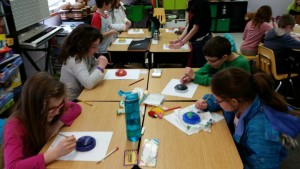 Science
Science
We reviewed the Big Bang Theory on Monday and I did a demonstration with the class using a balloon to show how the big bang would have worked. On Tuesday we took a virtual trip to Mars and we read a trade book on space. Thursday we started a lesson on Nicolaus Copernicus and we practiced our poem about space. On Friday the class began to do another space art project which you will see next week in the Hall. If you have time make sure you get a chance to read some of our space poems on the door, the class did a wonderful job with these. We definitely have some poets in our room.
English Spelling/Writing
This week for spelling we have done lots of activities, the classes particularly enjoying creating word searches and having someone else solve them. Our grammar review has been working on prepositions and prepositional phrases. For writing the class worked in their journals and wrote about their favorite native American group and why. Some students also worked on there space sonnet while others worked on their Native American Tic -Tac – Toe projects.
Art
The 2nd and 3rd graders learned how to make a clay coil pot in art this week. This ties in with their study of Native Americans, since all tribes made various forms of pottery. They made 2 small coil pots which will dry for a week, and then we’ll paint the pottery next week.
Music
We used today’s “Google doodle” to learn a bit about the history of the world’s first electronic musical instrument, the theramin, and it’s most famous exponent, Clara Rockmore, whose 105th birthday would have been today. We also learned the song Simple Gifts, both singing it and playing it on the Google theramin.
Theramin Link
by Sarah Segall | Mar 12, 2016 | In The Loop
Language Arts
In language arts we read a story called Adivina que/Guess What?
We also continued writing our friendly letters. We discussed that a writer must have his or her public in mind when writing. I mentioned that when writing a letter or a story they must determine who their audience is. Since the kids are writing their friendly letters to a class mate, the letter might have a more
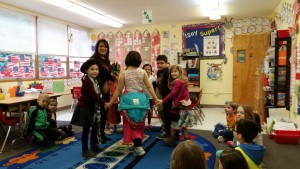
Performing for the kindergarteners.
casual tone. We discussed that in a friendly letter you can share an event that happened or say a kind word.
Phonics: We reviewed the diphthong -io, again using our blenders to make an -io smoothie.
The kids did an amazing job speaking Spanish this week in class and many spoke Spanish at home. One of the things we did for fun in the class room at the beginning of each day was to take our pretend Spanish vitamins! The kids think it helps them😊
Math
In math this week we learned how to regroup in two digit subtraction. The kiddos practiced converting tens/decenas to ones/unidades using concrete unit cubes and ten rods. Ask the kiddos to tell you about the green ten rods and yellow cubes which were a huge hit. They continued using their place value charts as visual aids in regrouping. We also learned a fun little tune to remind us the order in which to subtract: first subtract the ones and then the tens.
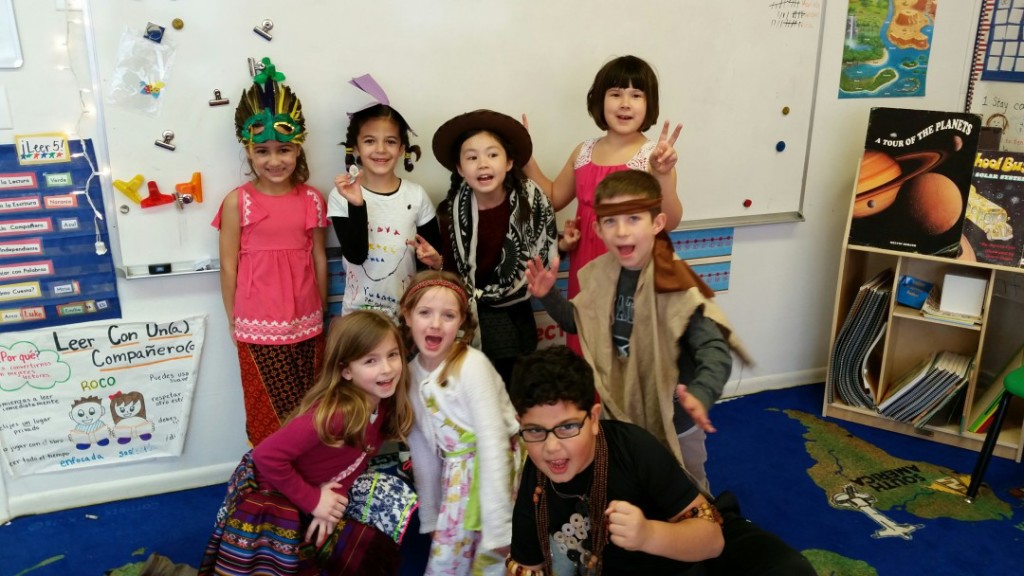
Social Studies & Science
This week we have been building up to our culminating ancient civilization day. We watched several animated children’s history videos on the Incas, Aztecs, and Maya. On Friday we had such a good time 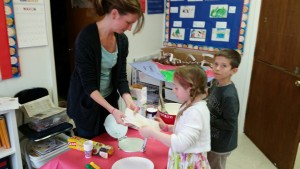 celebrating all that we have learned about the ancient civilization. The class got to try some foods that had their origins in the regions that we’ve learned about, they did some artwork, carving metal masks like the Incas, and they got to play some ancient civilization inspired games as well. Everyone had a great time. Thank you Jennie for all your help
celebrating all that we have learned about the ancient civilization. The class got to try some foods that had their origins in the regions that we’ve learned about, they did some artwork, carving metal masks like the Incas, and they got to play some ancient civilization inspired games as well. Everyone had a great time. Thank you Jennie for all your help
We have turned our attention to the moon this week in science. We’ve read several books about the moon and did a classroom project on phases of the Moon. If 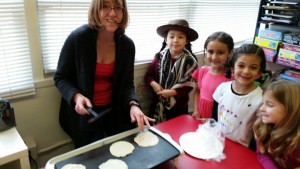 you get a chance make sure you read your child’s Moon story about The Man in the Moon on the bulletin board.
you get a chance make sure you read your child’s Moon story about The Man in the Moon on the bulletin board.
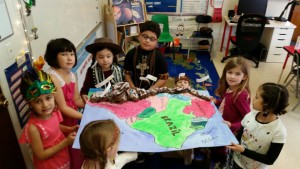 English Spelling
English Spelling
We worked on our sorts this week, I met with students in small groups to go over how we would do the sorts on Monday. The class then sorted their words and had me check to make sure they were on track. On Tuesday everyone did a sort activity as well as an additional sorting. I am very impressed how creative the classes with sorting activities I have several students to come up with new ways to demonstrate they are learning their words. German writing this week has been free choice which everyone always seems to like doing the best. The class is doing really well at checking the word wall words to make sure their spelling them correctly.
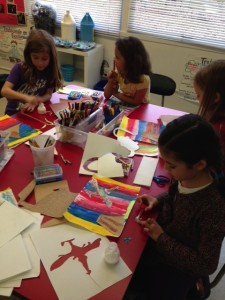 Art
Art
The first graders finished their dinosaur pictures today. They learned how to use basic shapes to draw various dinosaurs, and then they glued their dinosaur onto the painted background that they made a few weeks ago. They also added volcanoes, trees, and rocks to their prehistoric landscape. These great pictures are on the bulletin board at school.
Music
We worked today on a song that Sr Kit wrote: Cuando sale el sol, which leads us through a set of common early morning activities. We studied the musical notes of the song, and the fact that they represent varying lengths of time.
by Sarah Segall | Mar 12, 2016 | In The Loop
Language Arts
This week we really dug into the writing process. How does this work in kindergarten? Descriptive
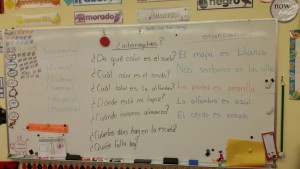
student sentences
writing describes people, animals, actions, places, things, ideas, objects, events, and so on. Descriptive writing can teach us about an unfamiliar or new topic. As a class we looked at a picture and listed all the people, animals, colors, and actions. This was our picture description.
We also talked a lot about the different types of sentences we use and read. We brainstormed and the class came up with a great list of the three types of sentences. We paid special attention to the punctuation used for each one.
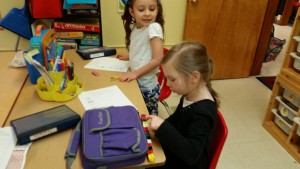
Measuring our lunch boxes was fun!
Math
We continued our measurement unit by incorporating estimation and lines of comparison. Here are a few great pictures showing a couple activities we did this week.
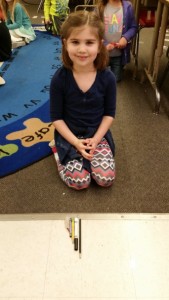
Using a line of comparison makes things easier to measure!
Social Studies & Science
This week we had the pleasure of Alora’s family sharing about their travels to many of our National Parks. They brought pictures and shared about their experiences. Don’t be surprised if your kiddo hits you up to visit a National Park this summer! Thank you Cook Family!
We learned about President Lincoln in more detail and discovered that he kept notes in his tall hat, including the Emancipation Proclamation. See if your child can tell you about this important note that he carried around for weeks before sharing it with his staff.
We also learned about Mt. Rushmore. We identified the presidents on Mt. Rushmore and learned that it is a monument. We learned how it was created, who designed it, and how long it took.
This is the end of our unit. We took an assessment on Presidents and Symbols and will start a new unit on animals next week.
Art
In Kindergarten art we started a “Windy Day Kite Picture.” We looked at 2 landscape paintings by Vincent Van Gogh, especially the curving, swirling lines in the skies that suggest windy weather. The students used tempera paint to practice painting swirly, curvy lines for the sky. Then they added a green field. This will be the background for their picture, and next week the students will add their person flying a kite. These “Windy Day” paintings will be as fun as their “Rainy Day” pictures, which I’ll return next week.
Music
This was a classical music day for the class, listening and moving to Grieg’s Morning Mood and In the Hall of the Mountain King. We also tied in the morning theme learning Sr Kit’s composition, Cuando sale el sol por la mañana.
by Sarah Segall | Mar 5, 2016 | Preschool
Piratas
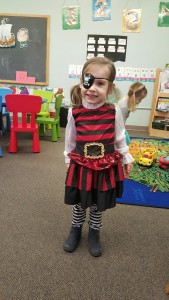 This week we finished with our unit of Piratas y Mapas/ Pirates and Maps. This topic was very creative with the little ones because it helped them to develop their imagination through many different activities.
This week we finished with our unit of Piratas y Mapas/ Pirates and Maps. This topic was very creative with the little ones because it helped them to develop their imagination through many different activities.
This week we also started working with and learning about the solar system/ El Sistema Solar. This topic gave us the opportunity to talk about what we already know about the solar system and then build upon that. We worked with a little introduction of the planets such as How many planets there are and their position from the sun. A favorite from this week was our new song about the planets. This will help us to 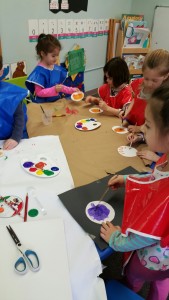 recognize the name and order of the planets.
recognize the name and order of the planets.
The activities in this theme will be very fun for all of us. We would love some help with prepping some of the tasks, if you are able. I will put these projects our on the desk in the hallway. Please ask if you have any questions or need clarification.
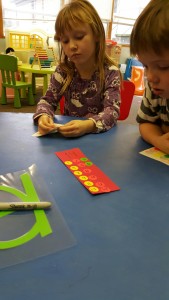 Las letras y los números
Las letras y los números
Our letter focus for the week was the letter R. The English letter name is pronounced as, R (ar), while the Spanish letter name pronunciation is; R (erre). Some examples we worked with this week were; regalo/present, reina/queen, rana/frog, ratón/mouse, robot/robot.
Be sure to point out the letters we practice as you are reading with your child.
Our number focus for the week was number 14/ catorce. They did an excellent job counting 1 through 14. We did different activities with this number such as counting and recognizing the number through dots and shapes. We also used our find motor skills for tracing the number 14 and counting in groups.
by Sarah Segall | Mar 5, 2016 | In The Loop
Language Arts
“Kid, you will move mountains” -Dr. Seuss
There is no better way to celebrate literacy than acknowledging one of our kids’ favorite authors and illustrators, Dr. Seuss. This week, we spent time reading some of the classics of children’s literature. Dr Seuss’ books always provide us with wonderful opportunities to not only play with words and creative illustrations, but also opportunities to think beyond the text and dig deep understanding the profound and powerful messages of his writing. The thinking strategies we practiced were Asking Questions and Making Inferences. Students did a marvelous job sharing their favorite quotes with the class!
Another fun activity we did this week to reinforce inferring skills were Adivinanzas. Adivinanzas (riddles) are a central part of Latin culture. Students were very accurate figuring out the text clues and thinking figuratively and literally to solve the riddles. Great job!
Book club update: Students are doing a great job keeping up with their reading assignments both, in class and at home. By Friday, they were expected to have read up until chapter 12 and filled out the corresponding logs. Next week we will be working on an activity that requires to have completed these parts. They are also encouraged to reread some chapters to be better prepared for the discussions.
We culminated our week having a very interesting discussion about the presidential candidates. We adults can learn a thing of two from our thoughtful children. The work ethic and respect that these kids show is absolutely outstanding. They are able to articulate their opinions in the most professional manner. I cant wait to see them put this knowledge and wisdom into practice when they write their persuasive essays next week!
Some of the grammar and word work included:
- Rules to form plurals in Spanish
- Accurate use of capital and lower case letters.
- Comparatives and superlatives (adjectives and adverbs).
- Spelling sentences
Students took home their new spelling sentences. As usual, we will have our Dictado on Thursday.
Science
Continuing with investigation 3: Water Tolerance , students isolated one factor, water, in the environment of plants, and set up and experiment to determine the range of water tolerance for the early growth of four different plants. Each student became an expert of a type of plant and had to follow their development very closely and share information with their groups. Based on our observations and our previous investigations we continued to discuss: what are the optimal conditions for each of four plants: corn, wheat, barley, and peas? What changes in the plants could they observe had taken place over the weekend? Over five days?
Students took home a new science book this week, Adaptaciones. Make sure your child practices his/her reading on a regular basis.
During this investigation students:
- Described the optimum water conditions for early growth of seeds.
- Analyzed data from plant experiments.
- Input information on data sheet.
- Checked their predictions.
- Compared and contrasted factors as well as plant growth and preferences.
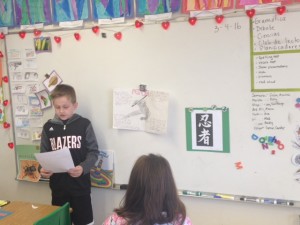 Math
Math
This week we dove deeper into algebra. The students did an excellent job of it and enjoyed the process as well!
In math your student should now be able to:
– explain what a variable is
– simplify algebraic expressions
– simplify expressions combing like numbers
– simplify algebraic expressions using addition
– simplify algebraic expressions using subtraction
– write an algebraic expression for real world problem solving
Looking for extra practice? Check out this site: Algebra
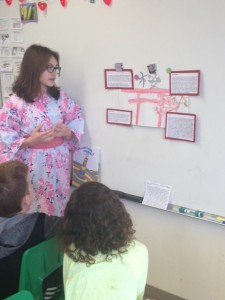 History & Geography
History & Geography
We started our unit on the westward expansion this week, read about Daniel Boone and Sacajawea, as well as early transportation and native Americans. On Friday the students did a phenomenal job of presenting their Feudal Japan projects that had been created at home during the week. Thanks again for your support with these amazing projects!
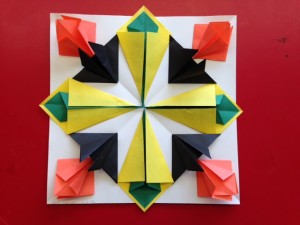 Art
Art
In 4th/5th grade art, the students started an Origami Radial Symmetry project. The students learned how to make 4 different Origami folds, and then made 4 samples in 4 different colors, of each fold. These will be glued on 12″ square paper to create a design with radial symmetry. We’ll continue this project next week, but check out Connor’s great design which he finished in one class! Great job everyone!
Music
Sr. Kit told some stories about his musician friends in Ecuador, and about the clothing donated here last year which was distributed to a large family whose mother is facing s serious illness.
by Sarah Segall | Mar 5, 2016 | In The Loop
Language Arts
We completed our very well liked imaginación unit. The students were all sad to see it end. The students have almost completed their realistic fiction writing pieces. They’ve walked through the entire process but this time they are taking it a step further by adding in ambiance. We are really working on painting pictures with our words. I look forward to the students publishing these pieces, as they have worked really hard on them.
We are adding verb conjugations to the back of our estudio de palabras journals. Students will be able to use these verb chart/flip books as a reference when they are writing. This week we added in the regular present tense verbs.
Spelling/ ortografia(words spelled with y or ll)
construyó
calle
cabello
llamaba
ayuntamiento
ayudaba
sencillas
ella
mayor
allí
llegar
ocotillo
llena
caballo
joyas
Math
This week we worked on equivalent fractions. We folded pieces of paper, drew lines on the folds, then folded each of those sections in half and drew lines on those folds. This was a great to see equivalent fractions.
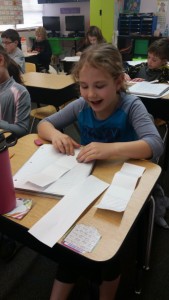
Folding and coloring? Yes, they help us compare fractions!
We also used our multiplication and division knowledge to identify equivalent fractions and also to reduce them.
On Thursday and Friday we began comparing unlike fractions. We learned:
- When fractions have the same denominator, you only need to compare the numerator to see which one is bigger or smaller.
- When fractions have the same numerator, the lower denominator is the greater fraction.
- Comparing unlike fractions can be done with number lines, diagrams, pie charts, or by using multiplication to make common denominators. (We will continue working on this concept next week.)
The students voted and elected to have daily math homework in place of a big unit packet.
Social Studies
This week we review what we’ve learned so far about the Native Americans of the southeast. On Tuesday we began reading about the Inuit of the Arctic and subarctic region. We learned that they were related to the Thule and lived in igloos for part of the year. They survived mainly by hunting at sea and on land. We learned that they invented the kayak and use it for hunting and transportation. They also relied heavily on the domesticated dogs for survival. They used them in teams to pull sleds and for hunting. On Friday we begin reviewing this unit to prepare for the domain assessment next Tuesday. The class has been taking notes throughout the unit and will be able to use these on the assessment.
Science
We have learned about the phases of the Moon this week. We also read about what it was like for astronaut to visited our close neighbor . We read about constellations on Tuesday, several students were excited to share what they knew about the naming of constellations. On Thursday the class read the poem Escape at Bedtime by Robert Louis Stevenson. We analyzed the poem, and then some students chose to illustrate it. The class continue to work on editing and publishing their own space poems. They are coming out quite beautiful and I can’t wait to share them with you on our classroom door. On Friday we begin reading about the Big Bang.
English Spelling/Writing
The class has continued to review what we’ve learned about past tense in grammar. We have been working on our sorts and activities all week, but on Thursday we took a break from our regular spelling routine. We celebrated Dr. Seuss’s birthday by reading two Dr. Seuss books and writing about our favorite Seuss stories in our journals.
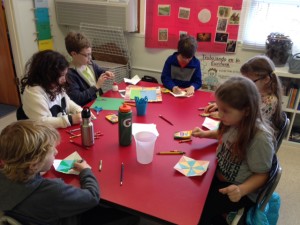 Art
Art
In 2nd/3rd grade art, some of the students needed to finish their “story quilts” and then we started a different type of quilt design using crayon resist. The students learned how to fold paper to create geometrical shapes, and then they added neon crayon for color. After crumpling their quilt pieces several times to create cracks in the crayon, the students painted on brown watercolor to make the crayon designs look like old fabric. Check out their great quilt projects on the bulletin boards at school!
Music
This week we reviewed songs from the core curriculum, adding two new ones: Simple Gifts and This Little Light of Mine.
by Sarah Segall | Mar 5, 2016 | In The Loop
Language Arts
This week in language arts we read a poem about trucks called Camiones. Some of the comprehension skills we worked with included:
-Comparing and contrasting
-Visualizing
Writing:
We wrote a friendly letter.
To warm up, the kiddos helped me write a friendly letter to Ms. Marci. It was so cute!
Phonics:
We learned about diphthongs/diptongos which are two vowels that together make one sound.
-ai, as in aire
-ay, as hay
-ei, as in seis
-ey, as in rey
To help reinforce these sounds, the kids had a blast making pretend “diphthong smoothies” by blending vowels together in their pretend blenders. Ask your child to show you.
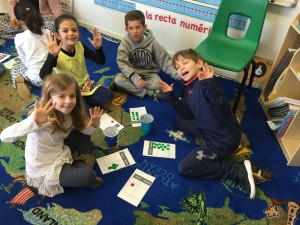 Math
Math
In math this week we practiced different ways to add larger numbers. Our main focus was the introduction of regrouping. We worked on:
-Addition by counting up by 10s, 2s or 1s.
-Addition by using a place value chart/tabla de valor posiciónal.
-Discussed regrouping by using a place value chart
-Played a game to demonstrate more concretely the process of regrouping in addition.
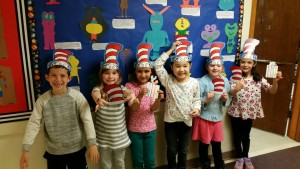 Social Studies & Science
Social Studies & Science
This week we finished up our Ancient Civilization of North America unit this week . We began by reading a little more on the Inca and then reviewed the other civilizations, Aztec and Maya, that we’ve learned about. We completed our class civilization chart and reviewed our own personal civilization charts. We read a trade book about the Incas and watched a short video on Inca ruins. On Thursday the class took their domain assessment on this unit. Friday we put together a class book using all of the illustrations that we’ve created throughout this unit. This week we also took a little time to celebrate Dr. Seuss’s birthday, we read a couple of Seuss books from our library and did some fun activities.
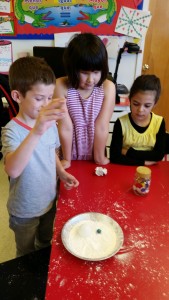
In science this week we learned a little bit about constellations. The class was so excited to learn about the different images in the sky at night and to share their own knowledge of some of these clusters of stars. On Tuesday the class had fun analyzing the poem
Wynken, Blynken and Nod and comparing it to another fictional story about the sky that we read together. On Thursday and Friday they wrote their own fictional story about the man on the moon. We had fun doing some experiments testing gravity and theorizing how craters are made on the moon. We learned the idiom “Hit the hammer on the head” this week.
English Spelling
We continue to work on last weeks sorts this week. Everyone was creative in coming up with new ways to do their activities. I met with different students throughout the week to help them better understand the vowel patterns that we were working with in these sorts. On Friday the class took their spelling test and did very well. They worked hard on these words and it shows.
In our journals this week we wrote an entry about our favorite Dr Seuss book and another on what “pictures” we see in the sky at it at night. On Friday the class had free choice writing and they also got to create their own Dr. Seuss “Wocket in a Pocket” piece.
Art
In first grade art, the students finished their collage “action” figures, adding details and a background. They did a great job creating figures jumping, waving, catching a football, etc. We enjoyed looking at their creative art on the white board. Then we had a few minutes to start a dinosaur drawing project which we’ll continue next week.
Music
Sr. Kit shared the story of how he first heard the class’ favorite song, La bamba, in Walla Walla. We then listened to three versions of La bamba, an early folk recording, a later and more sophisticated folk version, and Ritchie Valens’ rock and roll version from the 1950’s.
by Sarah Segall | Mar 5, 2016 | In The Loop
Language Arts
We talked about the different ways we show patriotism in our own families. Students illustrated this. Illustrations are an important part of story telling. Illustrations are not just about working on our fine motor skills but also about the thought process involved in adding details.
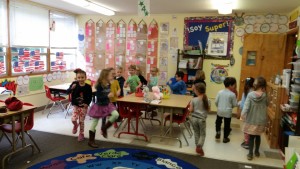
desfilar
Before reading our 4th of July story we previewed some important vocabulary words by acting them out.
Students wrote about how their family celebrates the 4th of July. Although many of celebrate in the same ways it was also fun to see how others celebrate.
Math
We worked on comparing t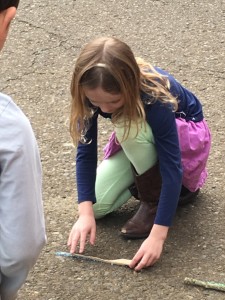 he length and height of objects by using both a set of 10 linking cubes and a line of comparison. Students found their objects and then shared their comparison sentences:
he length and height of objects by using both a set of 10 linking cubes and a line of comparison. Students found their objects and then shared their comparison sentences:
La flor es más alto que el trebol.
El trebol es más bajo que la flor.
El palo es iqual que la linea.
La roca es más corto que la linea.
La planta es más largo que la linea.
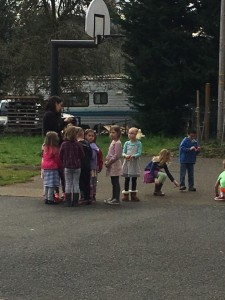
Taking math outside.
Social Studies & Science
Each day this week we read a Dr. Seuss book and did a special activity in honor of Dr. Seuss’ birthday and Read Across America. We read One Fish, Two Fish, Red Fish, Blue Fish, There’s a Wocket in My Pocket, ABC book and The Sleep Book. The students created their own Green Eggs and Ham class book and There’s a Wocket in My Pocket. These books will take turns going home overnight with each student and are to be returned the following school day. Enjoy!
This week we learned a bit more about George Washington. Ask your kiddo to tell you about his spectacles and how that helped calm his soldiers from trying to take over the country. We learned about Thomas Jefferson and his gift of writing, Abraham Lincoln and his efforts to end slavery, and Teddy Roosevelt. We learned about Teddy’s efforts in setting aside land to be preserved in it’s natural state creating National Parks for us all to enjoy.
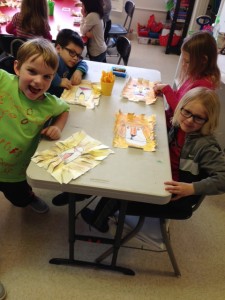 Art
Art
In Kindergarten art we talked about the month of March, the seasons of winter and spring, and the saying “March comes in like a lion.” We looked at Ed Emberley’s book about drawing animals, and the students made a stepbystep crayon drawing of a lion’s head, using basic shapes. The students did a great job creating these fun lions!
Music
This week we learned several new songs from the core curriculum, including The Teddy Bears’ Picnic, Kookaburra, You are my Sunshine and I Know an Old Lady.
by Sarah Segall | Feb 27, 2016 | Preschool
Los piratas y los mapas
This is our final full week with our pirate and map theme. We had fun walking the plank (or balance beam) while listening and singing to our pirate song. Walking on a balance beam is a great gross motor skill that we will continue to work on. 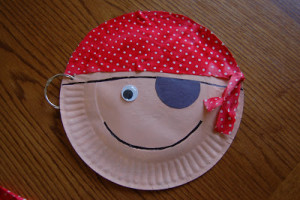
We also did a few more fun pirate crafts, really focusing on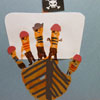 those location words from last week. Our pirate face and pirate ship hand were big hits!
those location words from last week. Our pirate face and pirate ship hand were big hits!
We used a new rug and followed rivers with our finger to see where the water flowed. Guess what! The rivers usually flowed into the ocean!
We played a fun math game where we rolled dice and then covered that many parrots on our paper. The first one to cover all their parrots wins! This game was great because it worked on so many skills:
- taking turns
- counting or identifying the number on the dice
- one-to-one correspondence (to cover the correct number of parrots)
- good sportsmanship if you win and if someone else wins
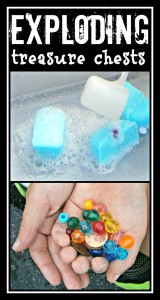 Pirate Science
Pirate Science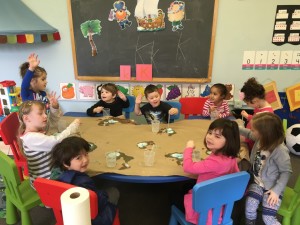
Pirate science? I’m sure your kiddos came home all excited about finding treasure. We had a blast doing PIRATE SCIENCE with Exploding Treasure Chests!! It was a great sensory experience as the solid, freezing cold chests turned to mush and exposed the treasures hidden within. The kiddos LOVED when the treasure chests “exploded”.
This activity also provided us extra practice with our fine motor skills while we squeezed the pipets.
Monday and Tuesday will be Preschool Pirate Day!! Send your child dressed like a pirate. We will also be welcoming back maestra Macky on Monday!
Next week we will start our new unit: El sistema solar – The solar system!! It will be a blast! We definitely have some big crafts associated with this theme and would appreciate any parent help! We find it easiest to set items on the desk in the hallway. Please be sure to ask if you need clarification on the projects.
Also, we need to collect paper bags for our astronaut suits and gallon milk jugs too!
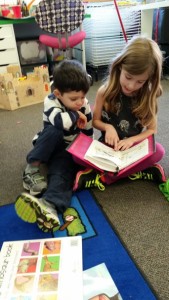
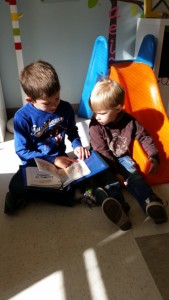 Las letras y los números
Las letras y los números
Our letter focus for the week was K. The letter K is the exact same in English and Spanish. In fact, all words with the letter K are foreign words that did not originate in the Spanish language: karate, kimono, kiwi
We also had the great opportunity to have the first graders come read to our preschoolers. This was a big hit!!
 History & Geography
History & Geography































